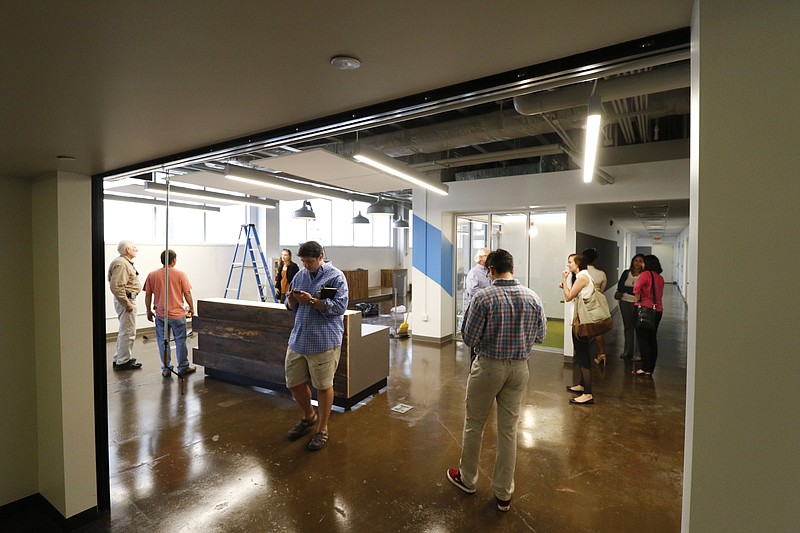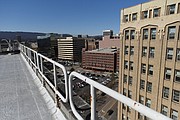There is something about a physical space that gives people a go-to point: a place to hunker down, but also one from which to launch. Take the simple example of your home: When you have a home base, it's generally easier to do what you need to do than if you are homeless.
The same logic can be applied to Chattanooga's innovation district, a delineated space whose purpose is to drive innovation, and, in turn, to drive economic growth. Many say the district is doing that, though some also say it's too soon to fully measure any impact.
The circular, 140-acre district, established almost two years ago, spans the University of Tennessee, Electric Power Board, Lamp Post Group and dozens of other entities relevant to the city's entrepreneurial scene. No zoning changes were needed to create it.
Innovation districts typically have several distinct characteristics: a density of companies and entrepreneurs, which can be a mix of startups and mature companies; a connection to higher education and the research and skills it offers; and a connection to what makes their city or area's economy special (in Chattanooga, that could be EPB and its smart grid).
"We are essentially promoting access – access to high-speed broadband, access to other entrepreneurs, access to creativity and collaboration, access to talented people with the skills to use these next-century tools," says Chattanooga Mayor Andy Berke. "When you have access to all of these assets in one, centralized geographic footprint you can start to generate an ecosystem for business development and growth."
This synergy and its tangible effect, particular to Chattanooga, has been noted by several organizations recently, including the Kauffman Foundation and the Brookings Institution.
"What's interesting about the Chattanooga district is the growth of this very collaborative, very entrepreneurial culture, supported by the mayor," says Bruce Katz, Centennial Scholar at the Brookings Institution. The Kauffman Foundation noted the same in "Little Town, Layered Ecosystem: A Case Study of Chattanooga."
Chattanooga doesn't have an advanced research university, but "it's making up for that by representing itself as a place, as something, where someone can come and start a business and grow a business and have access to capital and have support," Katz says. The city's high-speed internet, offered through EPB, is another asset.
"This is a different kind of play, but it's being watched very closely around the country," Katz says.
The front door for innovation
The district is anchored by the 10-floor Edney Innovation Center on Market Street, one lens through which to gauge progress. Careful strategy by the city and Hamilton County turned the building, a once-nondescript high-rise for the Tennessee Valley Authority, into a hub that now houses dozens of companies and groups.
The Edney is about 60 to 70 percent occupied, according to Ken Hays, president of the Enterprise Center, located in the Edney. Mayor Berke in 2014 charged the nonprofit organization with spearheading creation of the district.
For some, the innovation district has created big benefits. The Company Lab and Society of Work are two examples.
Co.Lab, the nonprofit organization whose mission is helping entrepreneurs, moved from the city's Southside to the ground floor of the Edney.
"It has made our job as 'front door' even easier by taking a metaphor and making it a reality," says Jack Studer, executive director of Co.Lab and a cofounder of the the Chattanooga-based venture incubator Lamp Post Group. "As natives to the innovation district, we can not only advise and connect, but we can now much more effectively shepherd young companies and entrepreneurs through the earliest and most confusing steps of the process."
The district gives aspiring and existing businesses a sense of place, local experts say.
"Many times, the beginning of the journey for entrepreneurs is confusing. What is the first step? Should I take the first step? Who can help me?" Studer offers. "By creating an intentional starting point, you create clarity and focus in a chaotic time. Then as the journey continues, you've similarly created a physical support structure. The entrepreneurial journey is at times amazing and blissful, but at times it can be even more profoundly lonely and desultory. Being around others going through similar life events can be a foundation upon which community is built."
Meanwhile, Society of Work, a co-working space with 80 members, has grown enough to expand to a second floor.
"The district definitely created a growth opportunity for us," says founder Kelly Fitzgerald, who moved the organization from elsewhere downtown. "The location where we were was not a bad location. But the synergy was not there. "
On another front, about $265 million of construction from private investment is underway or coming soon to the district, according to Kim White, president and CEO of the nonprofit downtown development group River City Company. That figure doesn't include renovations to Miller Park, Miller Plaza and Patten Parkway, which are expected to boost the district and all of downtown.
But the creation of the district isn't what spurred so much recent downtown development, many local experts say, the case in some other innovation districts.
"Putting up an 'innovation happening here' sign in downtown Chattanooga is more of an effect than a cause," says Mike Bradshaw, former executive director of Co.Lab. "While innovation of course happens in great companies of all kinds throughout Chattanooga, the tech-driven startup phenomenon bloomed in a concentrated area."
Still, it's not "a stretch" to say that labeling the geographic area an innovation district has been a boon to developers and downtown building owners, Bradshaw says.
Rising costs, border limits raise concerns
Not everyone is sold on innovation districts. Economic and planning experts at Harvard University have said it's too early to know if the districts can remake inner cities into powerhouses.
Edward Glaeser of Harvard Kennedy School told the Harvard Gazette in 2014 that they are an unproven hypothesis. Likewise, Jerold Kayden of Harvard's Graduate School of Design told the publication, "I think we're still operating more on intuition about what sorts of physical layouts promote innovation as much as evidence-based foundations. I think we all believe it. There are strands of evidence that support it. I just think we need to do more to really demonstrate that this is true and to indicate what are the best ways of laying out these districts beyond just calling one an innovation district and getting a lot of innovators to show up."
One of the biggest detractors inherent to districts is what they don't include, critics say. Studer of Co.Lab acknowledges this: "Obviously any time you make a choice to designate one area as the innovation district, you potentially leave out other areas of growth and enthusiasm and energy."
Case in point: the Hamilton County Small Business Development Center, also known as the INCubator, located in the North Shore neighborhood. It's outside the district's perimeter (though not by far), but has been one of the nation's largest business incubators, both in terms physical space and number of businesses.
The district wasn't drawn with an eye to excluding entities, Hays contends. Instead, it was drawn based on the guidelines Brookings laid out, among them zeroing in on a dense area.
"From Southside to North Shore was too big a geographic area to focus on," Hays says. "If you really want to see growth happen create a small compacted area, where you already have a lot of your innovation economy workforce."
And Chattanooga is small enough to "very fluidly integrate and involve other areas of town," Studer says.
There is also the inveterate problem of those on the fringe.
"When prosperity increases in an area, costs also go up," Bradshaw says. "This can further marginalize already marginalized populations. This effect is an unavoidable fact of economics and isn't particular to Chattanooga's innovation district. But, even if something borders on natural law it doesn't mean you can't protect people from the potential negative consequences of its action. Enhanced prosperity through entrepreneurship is for anyone that has an idea and is willing to do the work to make it a reality."
This is not a stretch. Programs available through Co.Lab and its related organization Launch, among others, help all types of entrepreneurs, not just those hip to the tech scene.
"If you're willing, you're in" Bradshaw says. "There are no social or economic qualifiers to participation, in theory."
That said, it helps for entrepreneurship programs to work with partners that have established relationships in neighborhoods that feel the effects of the Chattanooga renaissance but have not, in fact, benefitted from it, he says.
"Access to support networks is the issue," Bradshaw says. "We, as a community, have to do everything we can to support the development of neighborhood-based programs."
Likewise, digital equality is important, and something the larger community has to take on, Mayor Berke says. "We simply can't build digital gated communities. This is less a negative aspect of the district and more of a challenge all cities must face in the coming years."
Two initiatives are already working toward spreading digital access and knowledge locally, he points out: Tech Goes Home and NetBridge. Both originated in the innovation district.

